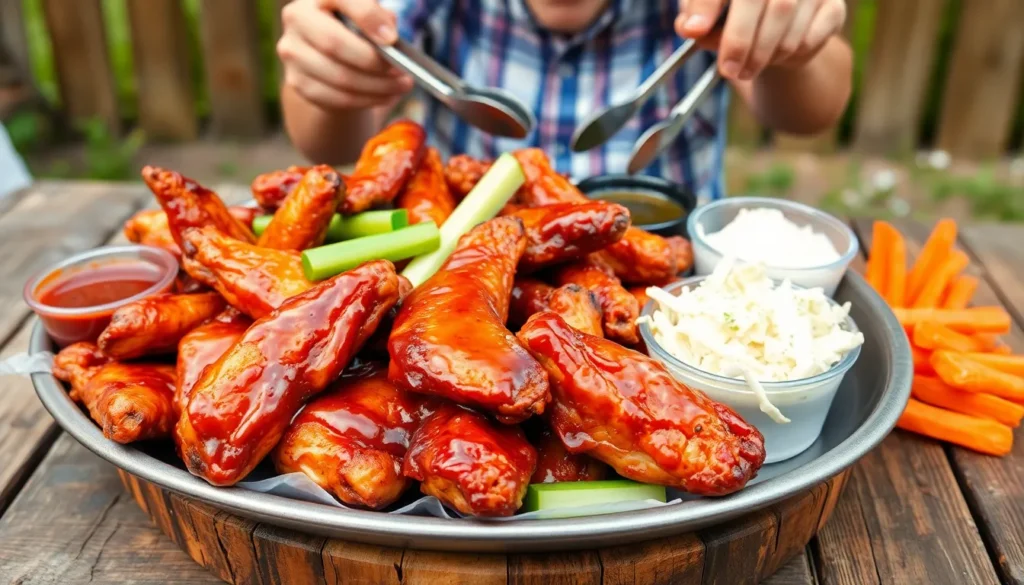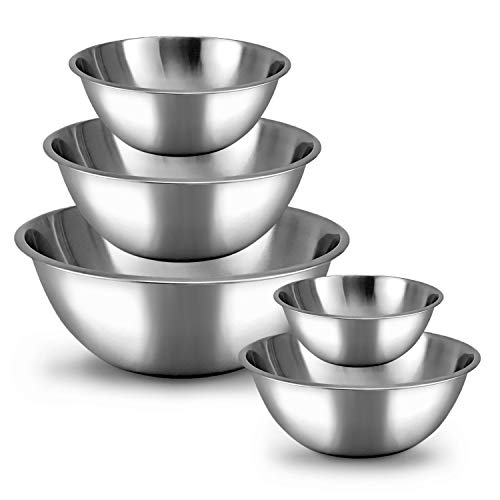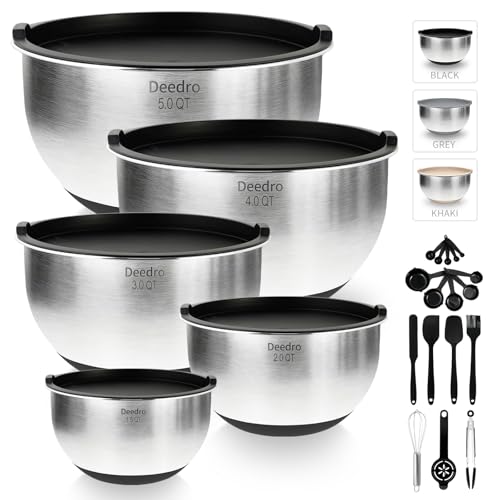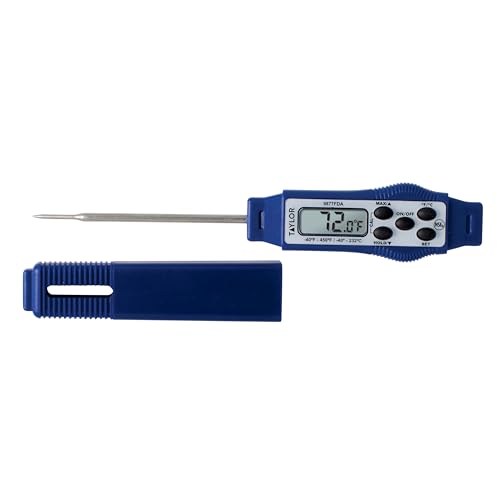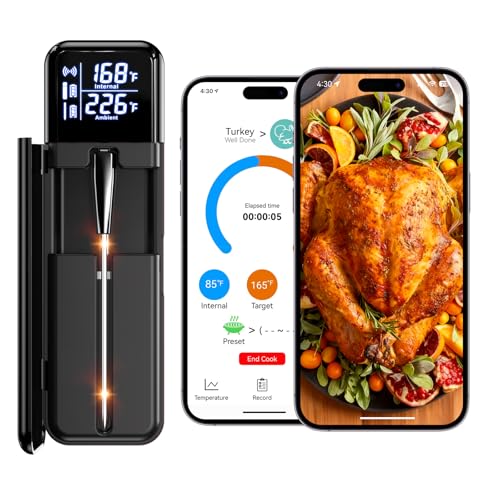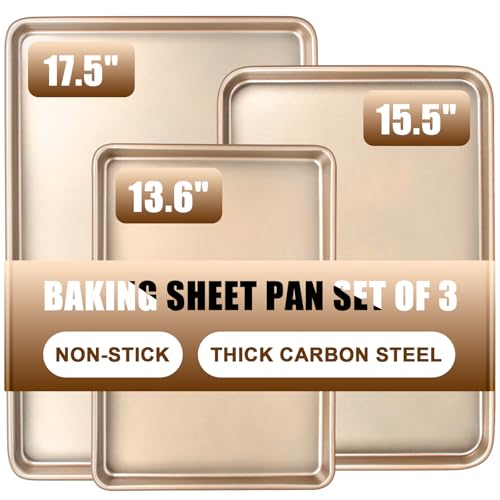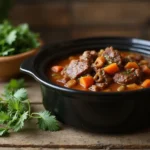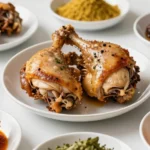When we crave the perfect balance of smoky flavor and juicy tenderness, nothing beats our smoked chicken wings recipe. These aren’t your ordinary game-day wings – we’re talking about wings that’ll have your neighbors peeking over the fence to see what’s creating that incredible aroma.
Smoking chicken wings transforms an already beloved appetizer into something extraordinary. The low and slow cooking process allows the smoke to penetrate deep into the meat while keeping it incredibly moist. We’ve perfected this technique to give you wings with crispy skin and meat that practically falls off the bone.
Whether you’re hosting a backyard barbecue or just want to elevate your weeknight dinner, these smoked wings deliver restaurant-quality results right from your own smoker. The best part? They’re surprisingly simple to make once you know our proven method.
Equipment Needed
We need exact equipment to achieve perfectly smoked chicken wings with that coveted crispy skin and tender meat. The right tools make the difference between mediocre wings and restaurant-quality results.
Smoker or Grill
Our primary piece of equipment is a smoker or grill capable of maintaining consistent low temperatures. We recommend pellet smokers for their precise temperature control and ease of use. Charcoal kettle grills work excellently with proper setup and damper adjustment. Gas grills with smoking boxes provide another reliable option for consistent results.
Instant-Read Thermometer
We rely on an instant-read thermometer to ensure our wings reach the safe internal temperature of 165°F. Digital probe thermometers with wireless capabilities allow us to monitor temperatures without opening the smoker frequently. This tool prevents both undercooked and overcooked wings.
Wood Chips or Pellets
We select exact wood varieties to complement our chicken wings. Apple wood provides mild sweetness while cherry wood adds beautiful color and subtle flavor. Hickory delivers stronger smoky notes for those who prefer bold taste. Oak offers balanced smokiness without overpowering the chicken.
Aluminum Foil Pans
We use disposable aluminum pans to catch drippings and prevent flare-ups. These pans also serve as water pans to maintain moisture levels during the smoking process. Heavy-duty versions withstand high temperatures better than standard foil pans.
Tongs and Heat-Resistant Gloves
We handle hot wings safely with long-handled tongs and heat-resistant gloves. Silicone-tipped tongs provide better grip without tearing the skin. Heat-resistant gloves protect our hands when adjusting vents or moving equipment during the cooking process.
Wire Cooling Racks
We place wings on wire cooling racks to promote air circulation and maintain crispiness. These racks fit inside sheet pans for easy transport and prevent wings from sitting in their own juices. Stainless steel racks withstand repeated use and clean easily.
Ingredients
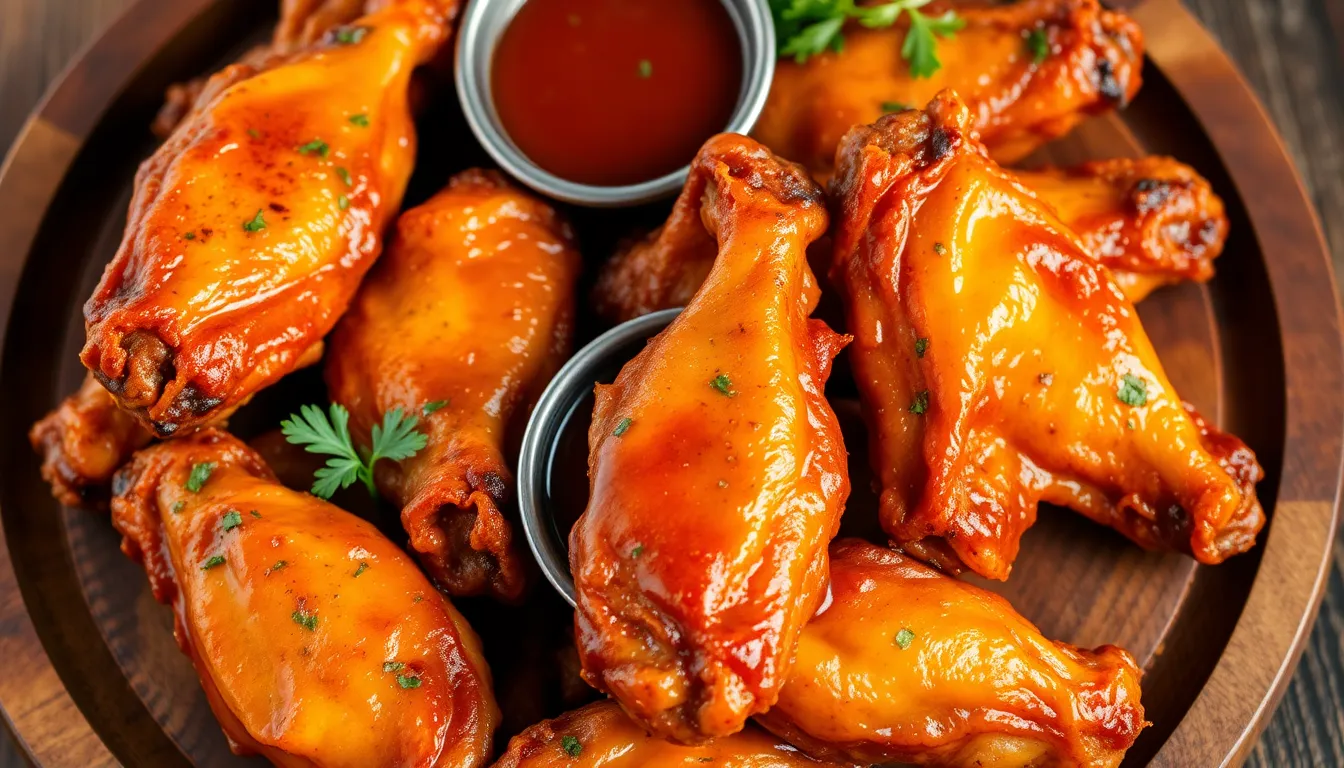
We’ve carefully crafted this ingredient list to deliver maximum flavor and crispy texture in every bite. Our selection combines essential proteins with aromatic spices that create the perfect balance of smoky and savory flavors.
For the Chicken Wings
- 2 pounds chicken wings (party wings recommended)
- 2 tablespoons olive oil (extra virgin or regular)
For the Dry Rub
- 2 tablespoons brown sugar (light or dark brown sugar)
- 1 tablespoon smoked paprika (or regular paprika if unavailable)
- 1 tablespoon kosher salt
- 1 tablespoon garlic powder
- 1 teaspoon onion powder
- 1 teaspoon ground black pepper
- 1/2 teaspoon chili powder or chili pepper (adjust for spice level)
- 1/2 teaspoon cumin
For the BBQ Sauce (Optional)
- 1/2 cup barbecue sauce (store-bought or homemade)
Prep Instructions
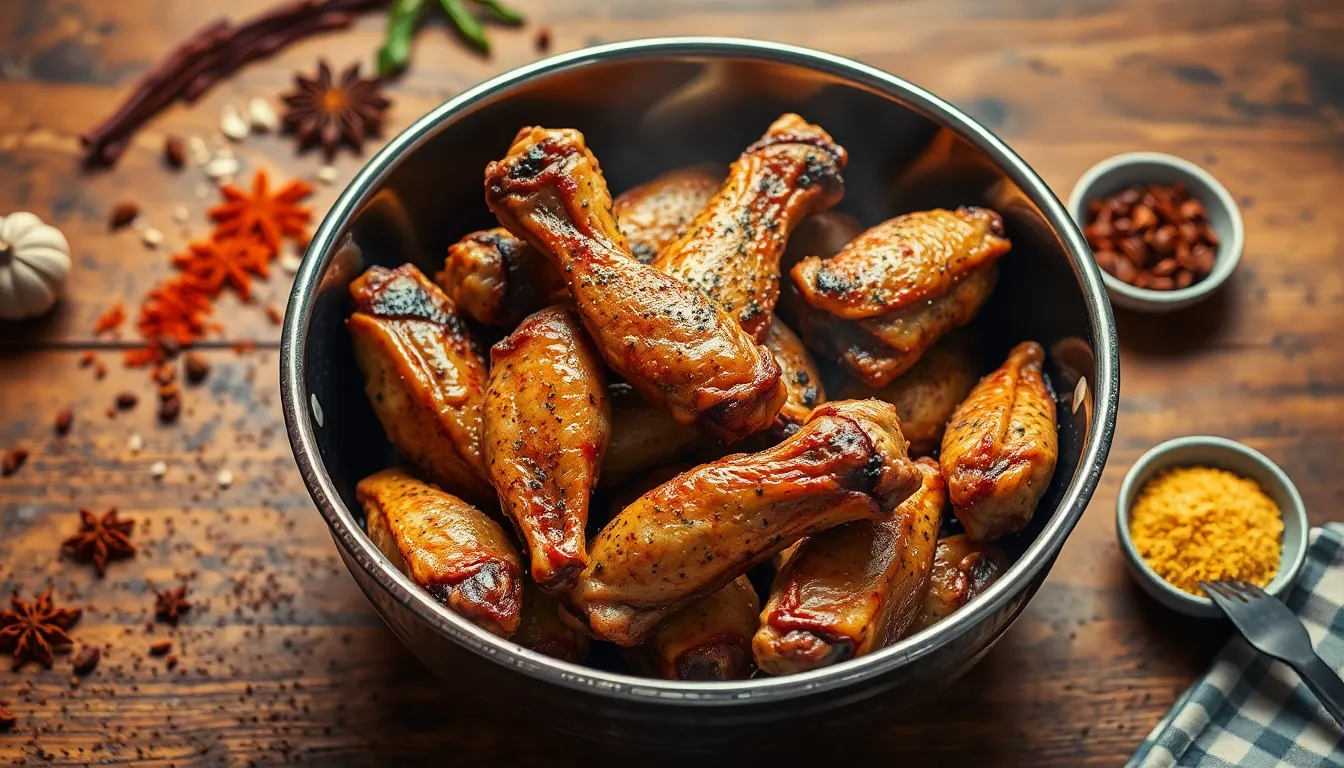
The foundation of exceptional smoked chicken wings lies in proper preparation and seasoning. We’ll walk you through each essential step to ensure our wings develop maximum flavor and achieve that coveted crispy exterior.
Preparing the Wings
We start by patting our 2 pounds of chicken wings completely dry with paper towels. This crucial step removes excess moisture that would otherwise prevent the skin from crisping during the smoking process. Next, we place the dried wings in a large ziplock bag or mixing bowl to prepare them for seasoning. The wings should be at room temperature for even cooking, so we remove them from the refrigerator about 30 minutes before we plan to start smoking.
Making the Dry Rub
Our dry rub creates the perfect flavor profile for smoked chicken wings. We combine 2 tablespoons of brown sugar with 1 tablespoon each of smoked paprika, kosher salt, and garlic powder in a medium bowl. To this base, we add 1 teaspoon each of onion powder, ground black pepper, and chili powder, finishing with 1/2 teaspoon of cumin. We whisk all ingredients together until the mixture is evenly combined and free of lumps. The brown sugar helps create caramelization while the spices build layers of complex flavor that complement the smoke.
Seasoning the Wings
We drizzle our 2 tablespoons of olive oil over the prepared wings, ensuring each piece gets coated. The oil helps the dry rub adhere to the wings and promotes even browning during smoking. Next, we sprinkle our homemade dry rub generously over the oiled wings, using our hands to massage the seasoning into every crevice. We make sure each wing is thoroughly coated with the spice mixture for consistent flavor throughout. After seasoning, we let the wings rest for 5 minutes to allow the flavors to penetrate the meat before transferring them to our preheated smoker.
Smoking Instructions
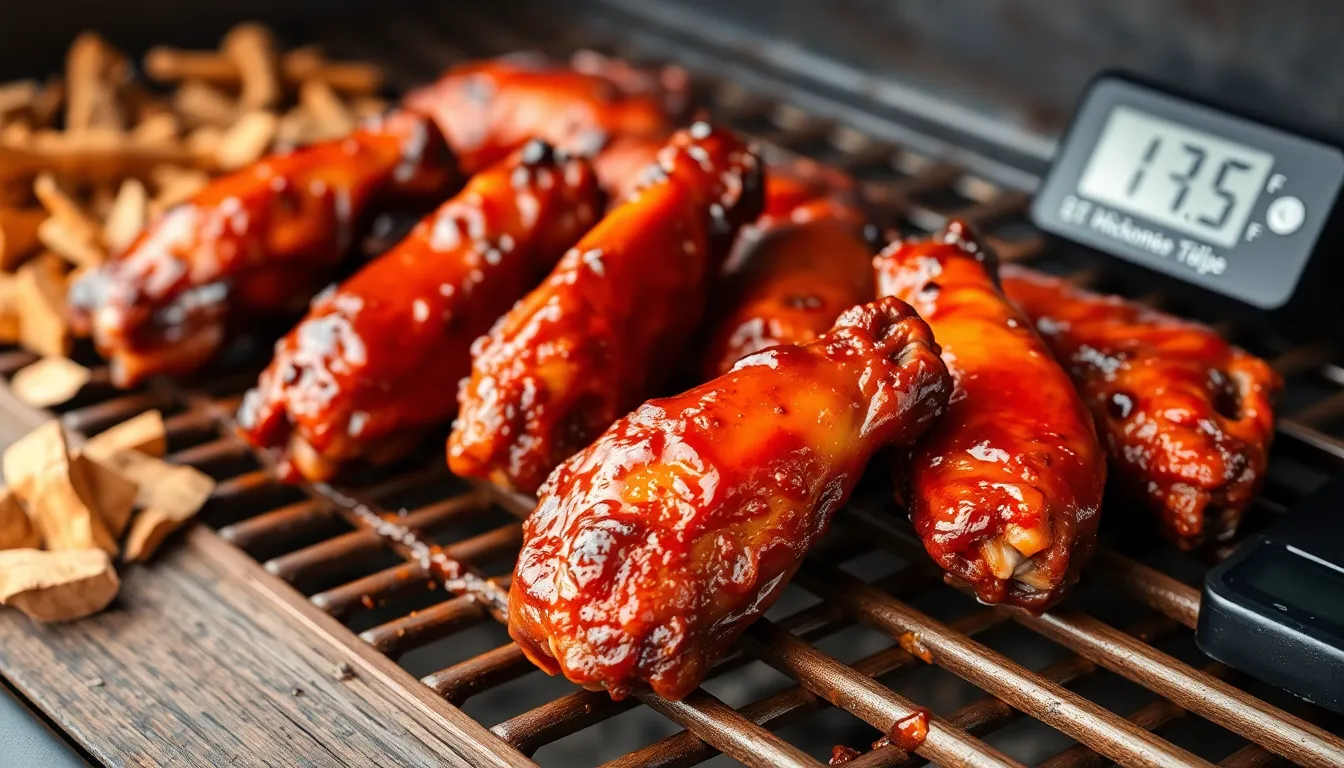
Now that we have our wings prepped and ready, let’s walk through the smoking process that transforms ordinary chicken wings into extraordinary barbecue masterpieces. The key lies in maintaining consistent temperature control and proper timing throughout the cooking process.
Setting Up Your Smoker
We start by preheating our smoker to 250°F, which provides the ideal temperature for infusing deep smoky flavors into the wings. Load your smoker with wood chips such as hickory or cherry wood to create that signature smoky taste we’re after. Position the wings on the smoker grate with adequate space between each piece to ensure proper smoke circulation around every wing.
Maintain indirect heat by placing the wings away from direct flames, allowing for slow and even cooking without the risk of burning. Keep airflow consistent throughout the smoking process and replenish wood chips as needed to maintain steady smoke production.
Smoking Temperature and Time
We begin the smoking process at 250°F for approximately 30 minutes to establish that foundational smoky flavor. Depending on wing size and your smoker’s consistency, this initial smoking phase can extend up to 90 minutes for maximum flavor penetration.
After the initial smoking period, we increase the smoker temperature to 425°F if you prefer crispier skin on your wings. Continue cooking until the wings reach an internal temperature of 175°F, which breaks down connective tissues and creates tender, juicy meat that falls off the bone.
| Smoking Phase | Temperature | Time Duration | Target Internal Temp |
|---|---|---|---|
| Initial Smoking | 250°F | 30-90 minutes | N/A |
| Final Cooking | 425°F | Until done | 175°F |
Monitoring the Wings
We regularly monitor our smoker temperature to ensure it stays within the optimal range throughout the cooking process. Use an instant-read thermometer to check the internal temperature of the thickest part of the wings for accurate doneness assessment.
Watch the wings carefully during the final stages, especially when applying sauce during the last 5-10 minutes of cooking. This prevents the sauce from burning while still allowing it to caramelize beautifully. Adjust cooking time based on wing size and your smoker’s performance characteristics to achieve consistent results every time.
Finishing Touches
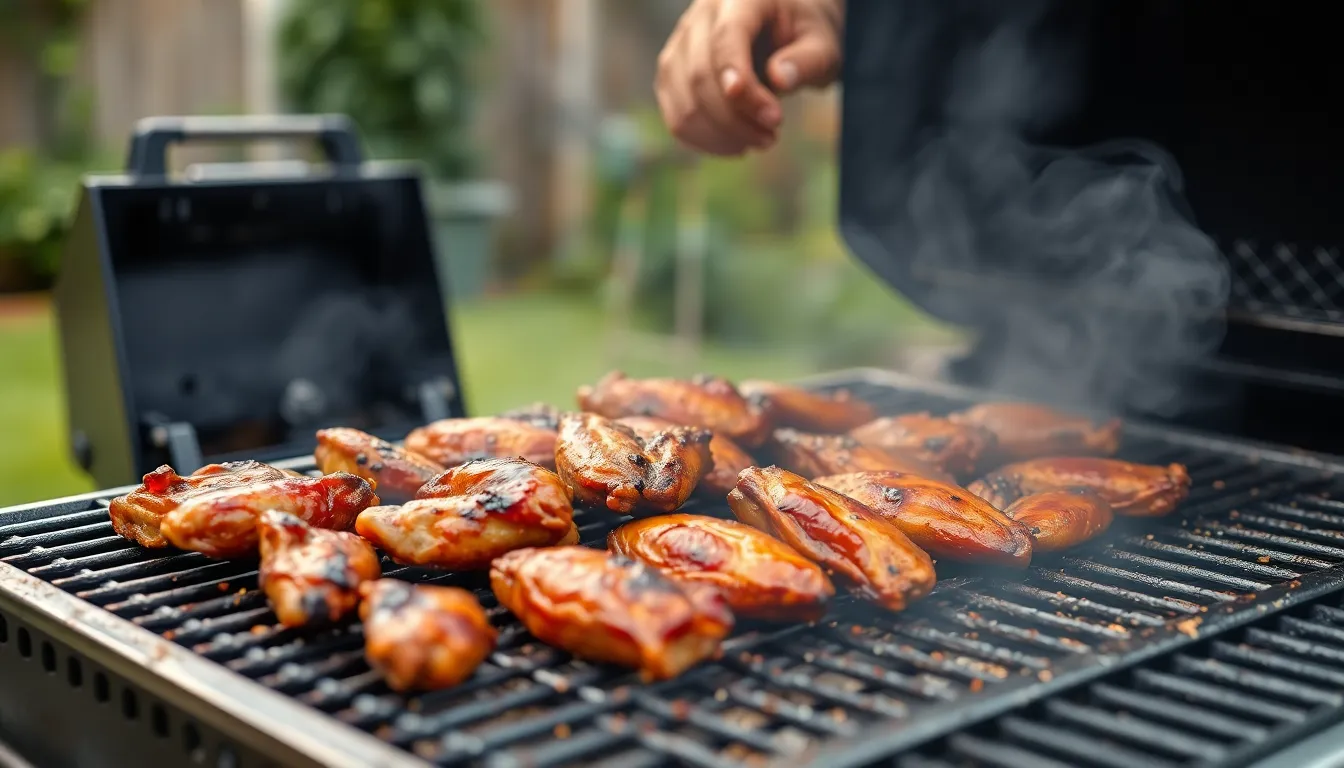
After our wings have absorbed all that delicious smoky flavor, we need to focus on creating the perfect texture and applying sauce properly. These final steps transform good smoked wings into extraordinary ones.
Crisping the Skin
We achieve crispy skin by increasing our smoker temperature to 425°F during the final cooking phase. This higher heat renders the fat under the skin while creating that coveted crunch without drying out the meat. Our wings need to maintain this elevated temperature until they reach an internal temperature of 175°F.
If our smoker cannot reach 425°F quickly enough, we transfer the wings to a preheated oven set to 425°F. Place the wings on a wire rack positioned over a baking sheet to promote air circulation. This method takes 5 to 10 minutes and delivers exceptional results.
The key lies in timing this temperature increase correctly. We monitor our wings closely during this phase since the higher heat works fast. Baking powder applied during preparation helps draw out moisture and promotes superior crisping during this crucial step.
Sauce Application
We apply barbecue sauce only after achieving crispy skin to prevent sogginess. Warm the sauce slightly before tossing our wings to ensure even coverage and better adherence. This timing preserves all the textural work we accomplished during the crisping phase.
For those who prefer glazed wings, we baste the sauce during the final 10 to 30 minutes of smoking. This approach allows the sauce to caramelize beautifully while still finishing with our high heat crisping technique. Monitor closely to prevent burning during this process.
Alternatively, we serve sauce on the side for those who enjoy controlling their flavor intensity. This method showcases the pure smoky flavor while accommodating different preferences at our table. Our wings taste exceptional either way, whether sauced or served dry with that perfect smoky bark.
Serving Suggestions
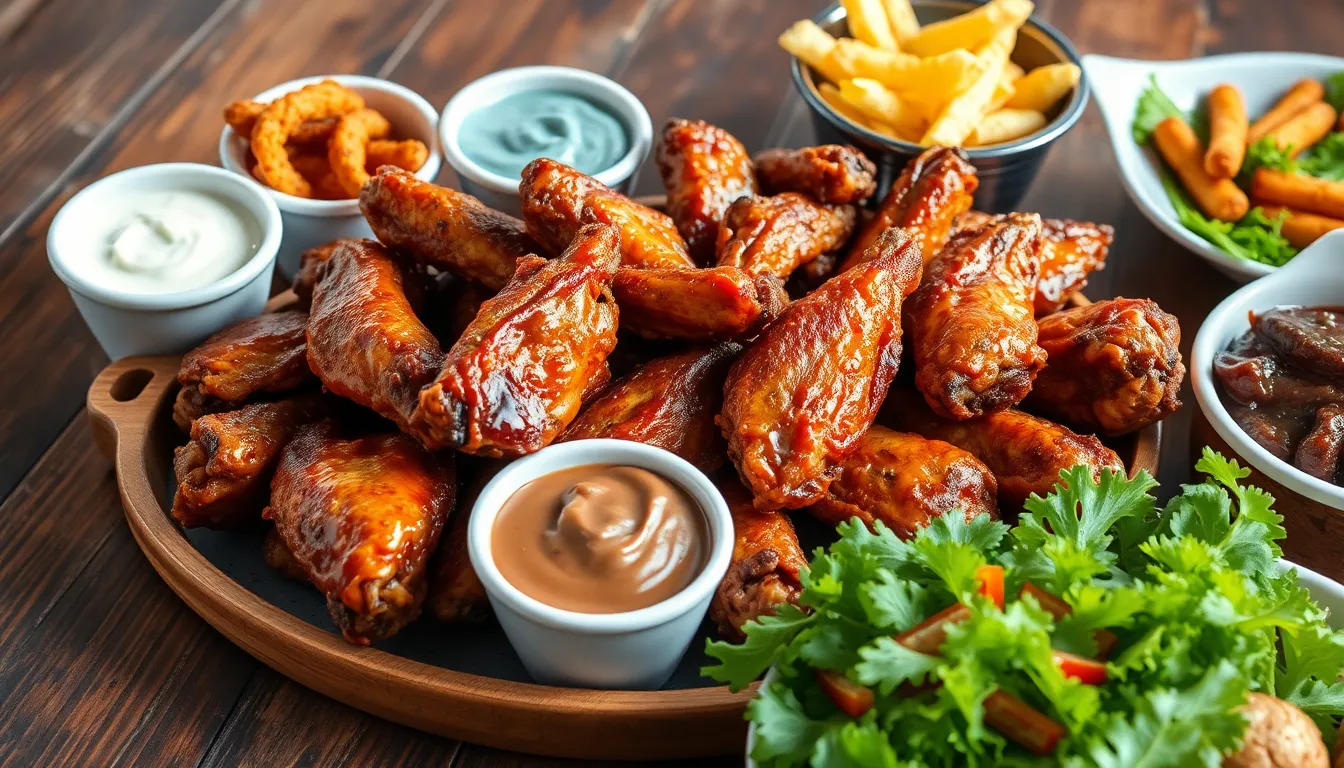
We recommend pairing our perfectly smoked chicken wings with classic sides that complement the rich smoky flavors. Onion rings provide a satisfying crunch that contrasts beautifully with the tender wing meat. Potato wedges offer a hearty starch that soaks up any delicious wing drippings. Fresh coleslaw adds a cooling element that balances the warm spices from our dry rub.
Vegetable sticks with creamy dips create a refreshing counterpoint to the smoky wings. We suggest serving carrot and celery sticks alongside ranch or blue cheese dressing for the perfect temperature contrast. These crisp vegetables help cleanse the palate between bites of flavorful wings.
| Sauce Option | Flavor Profile | Best Pairing |
|---|---|---|
| Ranch Dressing | Creamy, herbaceous | Complements spicy rubs |
| Blue Cheese | Tangy, bold | Balances smoky flavors |
| Barbecue Sauce | Sweet, smoky | Enhances wood smoke |
| Honey Mustard | Sweet, tangy | Pairs with brown sugar rub |
| Hot Sauce | Spicy, vinegary | Adds heat to mild wings |
Mac and cheese brings comfort food appeal to our wing spread. The creamy cheese sauce provides richness that pairs exceptionally well with the crispy wing skin we worked so hard to achieve. Baked beans offer another classic barbecue side that echoes the smoky theme throughout the meal.
Fresh green salad lightens the overall meal presentation. We recommend a simple mixed greens salad with vinaigrette dressing to cut through the richness of the wings. This fresh component helps create a well balanced dining experience that prevents palate fatigue.
Our smoked wings shine brightest when served immediately after cooking while the skin remains at peak crispiness. Arrange the wings on a large platter with small bowls of various sauces placed around the edges for easy access. This presentation allows guests to customize their wing experience while maintaining the optimal texture we achieved through careful smoking.
Storage and Reheating
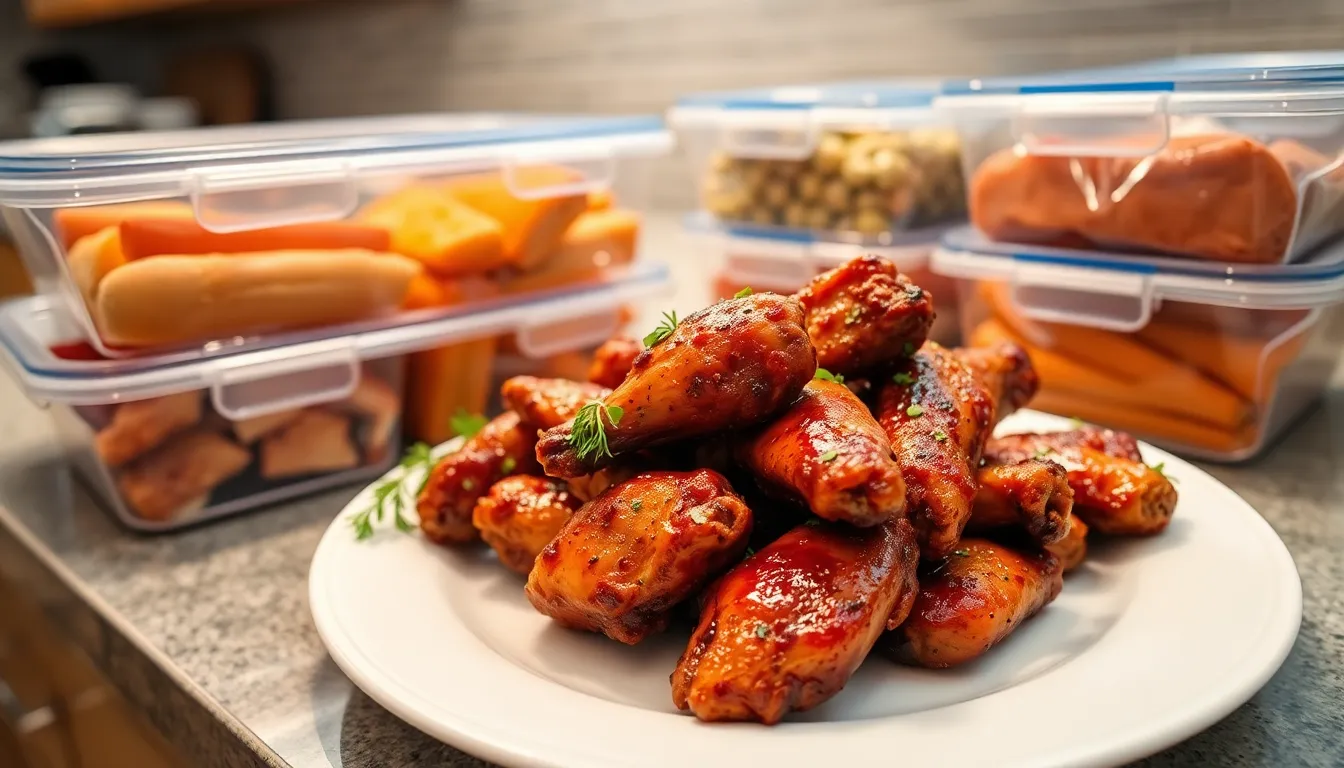
Proper storage extends the life of our smoked chicken wings while preserving their exceptional flavor and texture. We recommend storing leftover wings in airtight containers to maintain freshness and prevent contamination.
Refrigerator Storage
Fresh smoked wings stay safe in the refrigerator for varying periods depending on storage conditions. Most food safety experts suggest consuming refrigerated wings within 3 to 7 days for optimal quality.
| Storage Duration | Source | Notes |
|---|---|---|
| 3 days | The Big Man’s Industry | Conservative recommendation |
| 5 days | Midwest Foodie | Standard food safety guideline |
| 7 days | Kenneth Temple | Maximum recommended time |
Wings maintain their best texture during the first few days of refrigeration. Skin may begin to soften after extended storage periods. We suggest consuming wings within the first 3 days for the crispiest texture.
Freezer Storage
Freezing offers longer term storage answers for our smoked wings. Place cooled wings in freezer safe bags or containers to prevent freezer burn and maintain quality.
| Storage Method | Duration | Quality Notes |
|---|---|---|
| Freezer bags | 3-6 months | Varies by source recommendations |
| Airtight containers | 3-6 months | Prevents freezer burn effectively |
Some culinary experts advise against freezing smoked wings because thawing can make the skin rubbery and less appealing. We recommend consuming fresh wings when possible for the best eating experience.
Reheating Methods
Oven reheating delivers the most consistent results for restoring our wings to their original quality. Preheat the oven to 350°F and arrange wings on a baking sheet in a single layer. Heat wings for 10 to 12 minutes until they reach an internal temperature of 165°F.
Broiling for 2 to 3 minutes after initial heating helps restore the crispy skin texture that makes smoked wings so appealing. Monitor wings closely during broiling to prevent burning.
Air fryer reheating offers another excellent option for busy kitchens. Set the air fryer to 350°F and reheat wings for 5 to 10 minutes. This method effectively restores crispiness while heating the meat evenly throughout.
Temperature Safety Guidelines
Food safety requires heating all leftover wings to an internal temperature of 165°F before serving. We recommend using an instant read thermometer to verify proper heating. Wings reaching 175°F provide optimal texture while ensuring complete safety for consumption.
Never leave wings at room temperature for more than 2 hours before refrigerating or consuming. Bacteria multiply rapidly in the temperature danger zone between 40°F and 140°F.
Tips for Perfect Smoked Wings
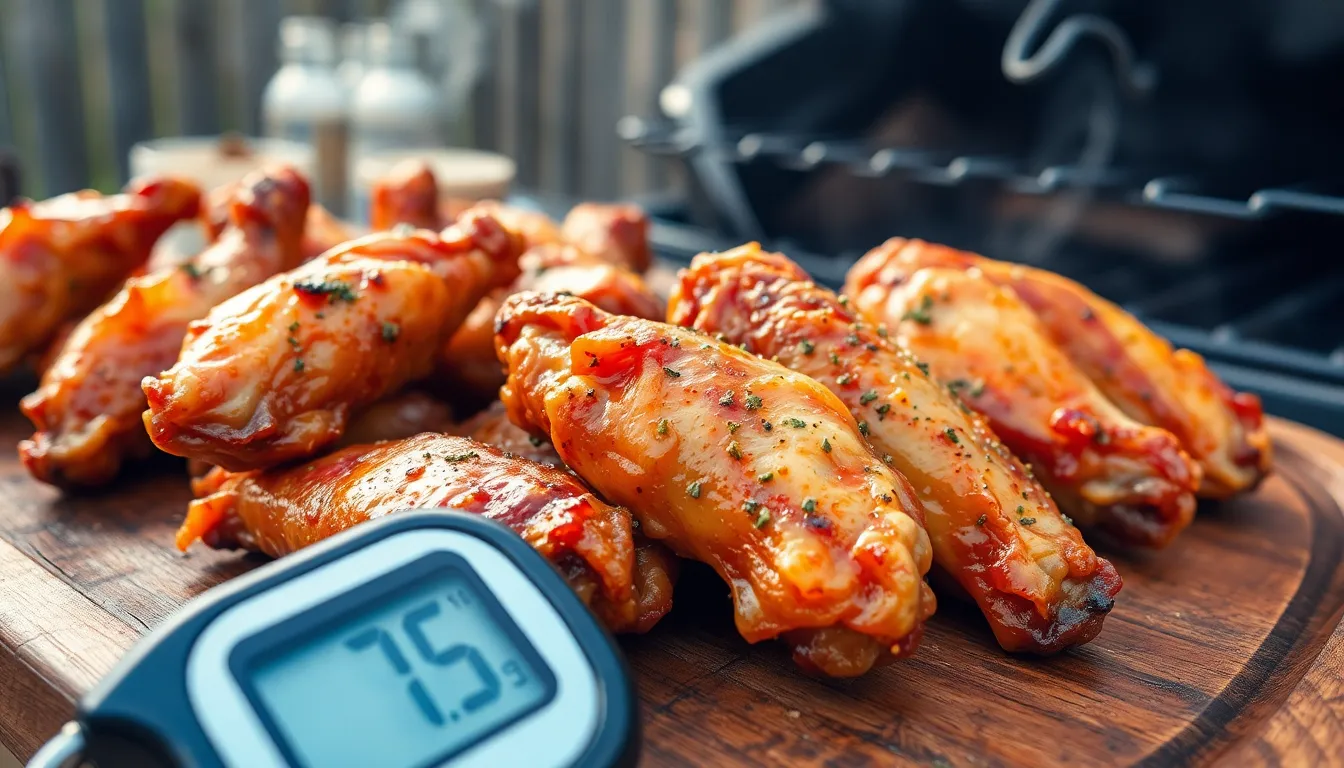
Mastering the art of smoked chicken wings requires attention to exact details that can make the difference between good and exceptional results. We’ve gathered proven techniques that consistently deliver restaurant-quality wings with that perfect combination of crispy skin and juicy meat.
Pat Wings Dry Thoroughly Before Seasoning
Moisture stands as the biggest enemy of crispy skin. We always use paper towels to completely dry each wing before applying any oil or seasoning. This crucial step removes surface moisture that would otherwise create steam during smoking and prevent the skin from achieving that desired crunch.
Apply Baking Powder for Enhanced Crispiness
Professional pitmasters swear by this technique. We toss wings in a mixture of baking powder and salt before applying our dry rub. The baking powder draws additional moisture from the skin while creating an alkaline environment that promotes better browning and crispiness during the smoking process.
Master the Low and Slow Then High Heat Method
Temperature control makes all the difference in achieving perfect texture. We start smoking at 225°F to 275°F to slowly render the fat and develop deep smoky flavor penetration. After 60 to 90 minutes we increase the heat to 425°F for the final phase to crisp the skin without overcooking the meat.
Avoid Overcrowding Your Smoker Grates
Proper air circulation ensures even cooking and smoke penetration. We always leave adequate space between each wing on the grates so smoke can circulate freely around all surfaces. Overcrowded wings will steam rather than smoke and result in uneven cooking.
Choose Mild Wood Types for Balanced Flavor
Apple cherry and hickory woods provide the ideal smoky flavor without overwhelming the delicate chicken. We avoid stronger woods like mesquite that can overpower the natural taste of the wings. These milder options complement rather than compete with our carefully crafted dry rub.
Only Smoke Fully Thawed Wings
Frozen wings create uneven cooking and poor smoke absorption. We ensure all wings are completely thawed and brought to room temperature 30 minutes before smoking. This practice guarantees consistent internal temperature and better flavor development throughout the meat.
Monitor Internal Temperature Accurately
Food safety and texture both depend on precise temperature monitoring. We use a digital instant-read thermometer to check that wings reach 165°F for safety and continue to 175°F for optimal tenderness. This temperature range ensures the meat stays juicy while the skin achieves maximum crispiness.
Time Sauce Application Strategically
Barbecue sauce timing can make or break crispy skin. We warm the sauce before application to prevent cooling the wings and only apply it after achieving crispy skin. Adding sauce too early creates steam that softens the exterior while finishing with sauce allows proper caramelization without burning.
Conclusion
Now you’re equipped with everything needed to create restaurant-quality smoked chicken wings at home. We’ve covered the essential equipment techniques and timing that make all the difference between good wings and exceptional ones.
The key lies in patience and attention to detail – from properly drying the wings to monitoring temperatures throughout the smoking process. With our proven method you’ll achieve that perfect balance of crispy skin and juicy tender meat every time.
Fire up your smoker and get ready to impress your family and friends with wings that rival any barbecue joint. These smoked wings will quickly become your go-to recipe for any gathering.
Frequently Asked Questions
What temperature should I smoke chicken wings at?
Start smoking at 250°F for 30-90 minutes, then increase to 425°F for crispy skin. This two-stage process ensures the wings cook evenly while developing a crunchy exterior. The wings are done when they reach an internal temperature of 175°F.
How long does it take to smoke chicken wings?
Smoking chicken wings typically takes 1.5 to 2.5 hours total. The initial smoking phase at 250°F takes 30-90 minutes, followed by 15-30 minutes at 425°F for crispy skin. Cooking time varies based on wing size and smoker efficiency.
What wood chips are best for smoking chicken wings?
Apple, cherry, hickory, and oak wood chips work best for chicken wings. Apple and cherry provide milder, sweeter flavors, while hickory and oak offer stronger, more traditional BBQ tastes. Avoid overpowering woods that can make the wings bitter.
Should I sauce my wings before or after smoking?
Apply barbecue sauce only during the last 10-30 minutes of smoking to prevent burning and maintain crispy skin. Alternatively, serve sauce on the side to preserve the wings’ texture and allow guests to customize their flavor preferences.
How do I get crispy skin on smoked chicken wings?
Pat wings completely dry before seasoning, use a mixture of baking powder and salt, and finish smoking at 425°F. Proper spacing on the grill grates allows smoke circulation. If your smoker can’t reach 425°F, transfer wings to a preheated oven.
Can I prepare the wings ahead of time?
Yes, you can season wings with the dry rub up to 24 hours in advance and refrigerate them. Remove wings from the fridge 30 minutes before smoking to bring them to room temperature for even cooking.
How do I store leftover smoked chicken wings?
Store leftover wings in airtight containers in the refrigerator for 3-7 days or freeze for 3-6 months. For best texture, consume within the first 3 days. Reheat in an oven or air fryer at 350°F to restore crispiness.
What sides pair well with smoked chicken wings?
Classic sides include coleslaw, potato wedges, onion rings, mac and cheese, and baked beans. Fresh vegetable sticks with ranch or blue cheese dip provide balance. A green salad helps cut through the rich, smoky flavors of the wings.
Do I need special equipment to smoke chicken wings?
You need a smoker or grill that maintains consistent temperatures, an instant-read thermometer, wood chips or pellets, and long-handled tongs. Heat-resistant gloves and wire cooling racks are helpful but not essential for successful wing smoking.
What’s the safe internal temperature for smoked chicken wings?
Chicken wings must reach an internal temperature of 165°F for food safety, though 175°F is recommended for better texture. Use an instant-read thermometer to check the thickest part of the wing for accurate readings.

